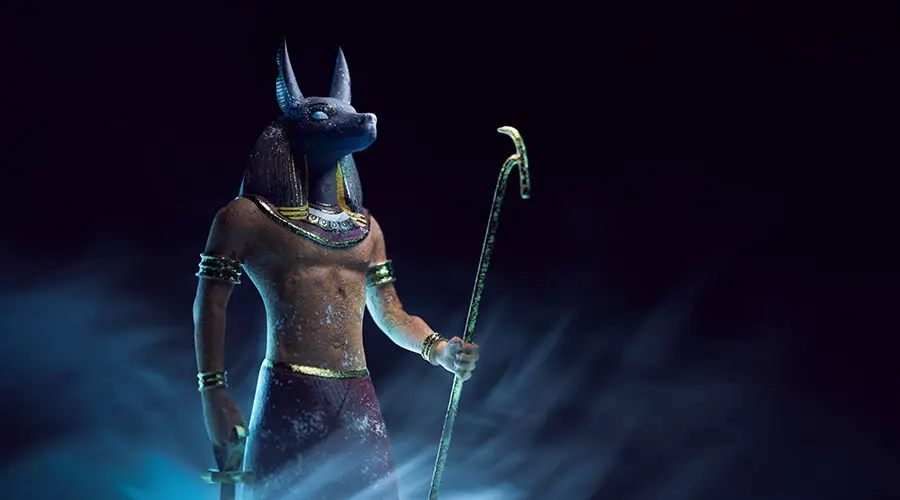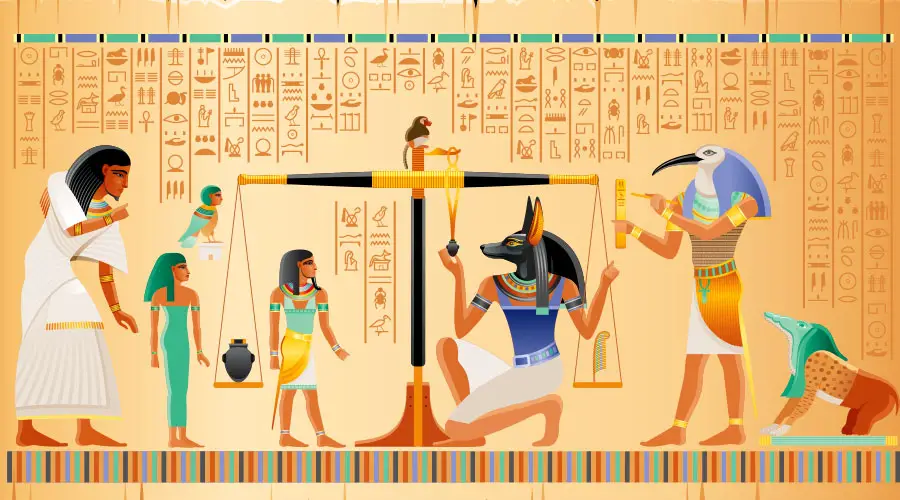Anubis the Egyptian deity is a protective god associated with death. One of the oldest of the Egyptian deities, he was worshipped for his protection, and was highly regarded for his important role in the journey after death.
Anubis the Egyptian god protected the dead while he accompanied them to the afterworld to conduct their judgement ceremony. With the head of a jackal, he was a strong canine god to protect the graves of the freshly deceased from wild dogs in the cemetery, as well as protect souls on their journey after death.
Anubis was regarded as the god of the dead during the Early Dynastic period and the Old Kingdom. Later Osiris became recognized as god of the dead, and the role of Anubis shifted to being the god of embalming, a practice that he invented.

Anubis is Frequently Seen in Egyptian Tombs
Despite there being relatively few myths about Anubis, he is probably the most popularly portrayed deity in Egyptian tombs, especially from the First Dynasty. He was the first deity to be portrayed in a tomb, and was usually shown performing mummification or funeral rituals for the Egyptian kings.
In the various artwork found, Anubis is portrayed as a well-built man with the head of a jackal, often with black skin. It is said that the black of the skin symbolizes both the fertility of the Nile River, and also the decomposing process of the skin of the deceased, over whom Anubis watched. At times he is also represented by a full jackal rather than merely having the head of one.
Anubis Invented Embalming
Anubis is most well-known as the inventor of embalming, a practice which was very important to ancient Egyptians, as they needed to properly prepare the physical corpse so that the soul could successfully make their journey in the afterlife.
Anubis performed the very first embalming on Osiris, who after the ceremony became the god of the Egyptian underworld. This was an important moment in Egyptian mythology, as well as for Anubis, as his role changed. Rather than being the god of the dead, as he had been known, Anubis was seen as a close collaborator with Osiris, who together conducted the affairs of bringing the newly deceased through the judgement process, and seeing them along to the afterlife.
Anubis would accompany the souls to the Hall of Truth, where they would be judged on how they had conducted themselves during their lifetime.

The Weighing of the Heart in the Hall of Truth
When the souls of the newly deceased were at the Hall of Judgement. Anubis would place their hearts on one side of the scale, and the feather of Maat on the other side, to determine if they were innocent or not.
The Feather of Maat was a white ostrich feather that represented Maat, the goddess of justice, truth, and harmony. This ceremony was a recollection of all the deeds, both good and bad, that the person had done in their lifetime. If the heart was equal in weight to the feather, the person was judged as being good. But if the heart was heavier, it meant that they had behaved badly in their life, and need to be punished.
Also present during the Weighing of the Heart was Thoth, the god of writing, who would record all of the judgements. Anubis had a daughter named Qebhet, who would bring water and offer comfort to the newly deceased during the ceremony.
The Parents of Anubis
Anubis and his role as the protector of the is better understood when we learn about his family background, and who his parents are. In Egyptian mythology, the struggle between Osiris and his brother Set is perhaps the most well-known myth. Anubis is actually the son of Osiris and the wife of Set, whose name is Nephthys.
Nephthys was married to Set, the brother of Osiris, but she desired Osiris. In order to seduce Osiris, she transformed herself to look like Osiris’s wife, Isis. Nephthys and Osiris then slept together, and she became pregnant with Anubis. Fearing that Set would learn of the baby, she abandoned Anubis shortly after he was born. But then Isis, the wife of Osiris, search for the baby and adopted him. Eventually Set did find out, which probably contributed to his eventual murder of his brother Osiris, and attempt to claim the throne.
Anubis and Osiris are frequently shown together, operating the afterworld. Anubis was regarded as Osiris’s loyal ally and colleague.

5 Interesting Facts About Anubis
The worship of Anubis was centralized in a city in Upper Egypt called Cynopolis.
The priests of Cynopolis who were dedicated to Anubis were exclusively male. His popularly reached beyond the city though, as he was recognized throughout Egypt and there were shrines to him across the entire kingdom.
Anubis was called the “First of the Westerners”
In ancient Egypt the afterlife was considered to be westward in the direction of the sunset. The recently deceased were called “Westerners”, as it was believed that their souls had simply relocated westward after death. Other names that Anubis were referred to by include “Lord of the Sacred Land”, “He Who is Upon his Sacred Mountain”, “Ruler of the Nine Bows”, and “The Dog who Swallows Millions”.
Anubis is the Greek Version of Anpu, which means “to Decay”
His name was in reference to the process through which the corpses of the deceased would go through. The elaborate mummification processes developed in ancient Egypt, the invention of which was attributed to Anubis, were intended to preserve the body in order to support the soul of the deceased on their journey.
Anubis was Combined with Hermes to become Hermanubis
As was popularly done in ancient Greek and especially later in Hellenistic times, the pantheon of gods would be reimagined and reconfigured as new syncretic deities. One example of this was the combining of Anubis and Hermes to become Hermanubis, who was popular during the time the Romans ruled over Egypt, and was also a conductor of souls.
Anubis was Famously Portrayed in a Statue in the Tomb of Tutankhamen
One of the most famous discoveries in the history of Egyptology is the tomb of the pharaoh Tutankhamen, Within the tomb was discovered a statue of Anubis, portrayed in full animal form, positioned to guard the tomb of the pharaoh.
Recommended Reading
If you want to continue exploring this subject more deeply, you can see which books I recommend by clicking here.
